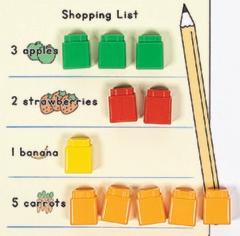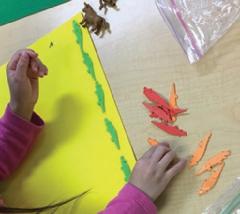
2 minute read
Overview
Kindergarten Module 2
Kindergartners do not need prior experiences with Eureka Math or any preschool curriculum to be successful at the beginning of this module.
Kindergartners do not need prior experiences with Eureka Math or any preschool curriculum to be successful at the beginning of this module.
However, many modules from prekindergarten directly support the work in this module. They prepare students to successfully count groups of 0 to 10 objects and find or write the matching numeral. They also set the foundation for using one-to-one correspondence as a way to determine whether there are enough.
However, many modules from prekindergarten directly support the work in this module. They prepare students to successfully count groups of 0 to 10 objects and find or write the matching numeral. They also set the foundation for using one-to-one correspondence as a way to determine if there are enough.
Counting and Cardinality
Topic A
Classify to Make Categories and Count
Classifying objects into groups by attribute creates a natural context for counting and working with numbers. Students are introduced to four core ideas about counting, which are collectively referred to as the number core. (See the Why section.)

Topic B
Answer How Many Questions with Up to 5 Objects
Students integrate the elements of the number core while considering different ways and reasons to count. They learn three strategies to help them count accurately regardless of configuration: touch and count, move and count, and mark and count.
Topic C
Write Numerals and Create Sets of Up to 5 Objects
Students begin to write numerals and experience more complex counting situations, like counting sounds and words that can be heard but not seen. They count out objects to match a given number. They also count to find out whether they have enough of something.

Topic D Decompose Numbers
Students explore number relationships. This begins with the familiar context of sorting and then moves to story problems. Students begin to use number sentences like 5 is 2 and 3. These early experiences with problem solving set the stage for work with addition and subtraction concepts in modules 4 and 5.
Topic E
Answer How Many Questions with Up to 10 Objects
Topic E builds on the work of topic B as students apply number core concepts to sets of 6 to 10 objects. As the size of the group gets larger, tracking the count becomes more challenging. Students consider how to choose an accurate counting strategy.
Topic F Write Numerals and Create Sets of Up to 10 Objects
Topic F provides space to practice counting while students learn to write 6, 7, 8, 9, and 10. Students count things that happen over time, like a person’s jumps or the runs in a baseball game, and see that writing numbers is a good way to record and remember that information.
Topic G
Analyze the Count Sequence
Students analyze the count sequence focusing on the ideas that each successive number is 1 more when counting forward and 1 less when counting backward. The number stairs model clearly illustrates these patterns.
10987654321
After This Module
Kindergarten Module 2
Students apply their ability to isolate and sort by attributes, including number, as they analyze and compare shapes in module 2. They count sides and corners as they name, compare, model, and compose shapes.
Answer How Many Questions with Up to 5 Objects
Conserve number regardless of the arrangement of objects.
Order numerals 1–10 and reason about an unknown number in the number sequence.
Analyze the Count Sequence
Lesson 29
Model the pattern of 1 more in the forward count sequence.
Lesson 30
Build number stairs to show the pattern of 1 more in the forward count sequence. Lesson
Model the pattern of 1 less in the backward count sequence.
Build number stairs to show the pattern of 1 less in the backward count sequence.
33




